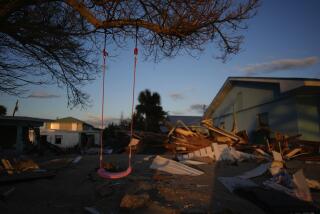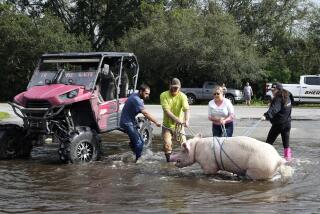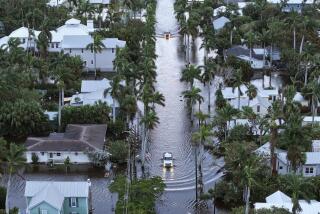St. Thomas Reeling From Storm’s Devastation
- Share via
CHARLOTTE AMALIE, U.S. Virgin Islands — The yachts that used to be in the marina are on the highway. The red roofs of houses are strewn on the ground. The duty-free shops where tourists used to look for bargains are filled with looters.
Hurricane Marilyn has moved on from St. Thomas, but the Caribbean island that it left behind was a changed place Sunday.
Electricity, water and phones were out. A quarter of the houses on the island were destroyed, and nearly all the others damaged.
Air traffic controllers, the windows of their tower blown out by 110-m.p.h. winds, used binoculars and radios to guide in relief flights. Seven military transport planes landed Sunday on St. Thomas with the first supplies for residents.
In Charlotte Amalie, capital of the U.S. Virgin Islands, hundreds of people looted stores at a waterfront shopping center. No police officers were in sight.
The hurricane, the fourth to hit the Caribbean in as many weeks, tore through the Virgin Islands and eastern Puerto Rico on Saturday, blowing apart homes, tossing parked airplanes into the air and killing as many as nine people.
At least six people were killed on St. Thomas, home to 51,000 people. Two died on St. Croix, the most populous of the Virgin Islands, with 55,000 people. One person was killed in Puerto Rico.
On St. Thomas, many buildings lost facades, gaping open like dollhouses. The Federal Emergency Management Agency at first said half of the island’s houses were destroyed but later said a quarter were destroyed and 75% damaged.
Marilyn blew out the windows of St. Thomas’ hospital and flooded it, making it virtually unusable. Doctors were trying to care for 49 patients, including nine critically injured in the storm and four on life-support units with generator power, said Dr. Manuel Guzman.
One stretch along the waterfront was blocked by two 30- to 40-foot yachts blown onto the road from the bay.
At least 50 people were injured or missing on St. Thomas, although FEMA said an earlier report of up to 50 people trapped in a collapsed apartment complex in Charlotte Amalie was incorrect.
Communications to St. Thomas were out, and FEMA set up two satellite telephones Sunday. AT&T; was sending a team to replace a microwave dish Marilyn toppled.
By Sunday evening, Marilyn was pursuing a harmless route through the open Atlantic. Its top winds had dropped to 90 m.p.h., and it was about 680 miles south-southwest of Bermuda, moving north.
In Japan on Sunday, one of the most powerful typhoons to hit the nation since World War II dealt the eastern coast a glancing blow before veering back out to sea.
Rescue authorities counted themselves lucky that the winds of up to 125 m.p.h. and heavy rain that went on for hours did not cause more havoc in the country’s most densely populated area.
The typhoon lashed Tokyo for several hours, causing massive chaos as all airports were shut and trains were either canceled or ran at reduced speed. By midafternoon, more than 12 inches of rain had fallen in some places.
Police said three people were confirmed dead in accidents connected with the typhoon on land and six people were missing and feared dead in incidents at sea. They said about 50 people were injured by falling debris.
As of 9 p.m. Sunday, Oscar was located at sea about 600 miles northeast of Tokyo and was headed northeastward, farther out to sea.
More to Read
Sign up for Essential California
The most important California stories and recommendations in your inbox every morning.
You may occasionally receive promotional content from the Los Angeles Times.










